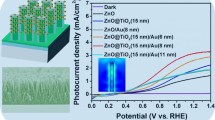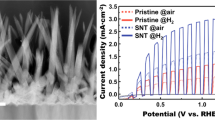Abstract
Photoelectrochemical zero bias hydrogen generation has been achieved with self-assembled nanoporous anatase type TiO2 (SANAT) photoelectrode and chemical bias. The SANAT fabricated using halogen free conventional electrolytes by anodization exhibits more than 2 times superior performance to rutile single crystal electrodes in photoelectrolysis of water. The chemical bias assisted cell consists of two separate compartments connected by a liquid junction. The SANAT anode is immersed in alkaline electrolyte, Pt cathode is in acidic electrolyte. The use of electrolytes of two different pH values produces a chemical bias of 0.059 ∆pH V due to the proton concentration gradient. Under zero bias condition, photocurrent sufficient for photolysis of water was observed. Hydrogen evolution was visible at counter electrode without the application of any external voltage. We call this system fuel type photoelectrochemical zero bias hydrogen generation or water splitting.
Similar content being viewed by others

References
A. Fujishima and K. Honda, Nature, 238, 37 (1972).
A. Fujishima, K. Kohayakawa and K. Honda, Bull. Chem. Soc. Jpn., 48, 1041 (1975).
A. Fujishima, K. Kohayakawa and K. Honda, J. Electrochem. Soc., 122, 1487 (1975).
A. J. Nozik, Nature, 257, 383 (1975).
T. Watanabe, A. Fujishima and K. Honda, Bull. Chem. Soc. Jpn., 49, 355 (1976).
J. Akikusa and S. U. M. Khan, Int. J. Hydrogen Energy, 22, 875 (1997).
T. Bak, J. Nowotny, M. Rekas and C.C. Sorrell, Int. J. Hydrogen Energy, 27, 19 (2002).
Y. Kamo and K. Sakamaki, NCSS2010, Chiba, Japan, Sept. 19–22, Abstr., No. 1PD31, p.164 (2010).
K. Sakamaki and Y. Kamo, 62nd ISE, Niigata, Japan, Sept. 11–16, Abstr., No. s9-P-041 (2011).
K. Sakamaki, Y. Kamo and K. Uchida, IACIS2012, Sendai, Japan, May 13–18, Abstr., No. S5P16-03 (2012).
M. Sato, Y. Kamo and K. Sakamaki, The 93rd Spring Meeting of Chem. Soc. Jpn., Shiga, Japan, Mar., 22–25, Abstr., 1PB-029 (2013).
H. Endo, M. Sato, Y. Kamo and K. Sakamaki, 2013 Autumn Meeting of The Electrochem. Soc. Jpn, Tokyo, Japan, Sept., 27–28, Abstr., No. 2K18, p. 194 (2013).
F. Izumi and K. Momma, Solid. State Phenom., 130, 15 (2007).
S. Roy Morrison, Electrochemistry at Semiconductor and Oxidized Metal Electrodes, (Plenum Press, New York, 1980).
Author information
Authors and Affiliations
Rights and permissions
About this article
Cite this article
Sato, M., Kamo, Y. & Sakamaki, K. Chemical Bias Coupled Photoelectrochemical Zero Bias Hydrogen Generation Utilizing Self-Assembled TiO2 Nanoarchitecture Electrode. MRS Online Proceedings Library 1601, 1601 (2013). https://doi.org/10.1557/opl.2013.1149
Published:
DOI: https://doi.org/10.1557/opl.2013.1149



